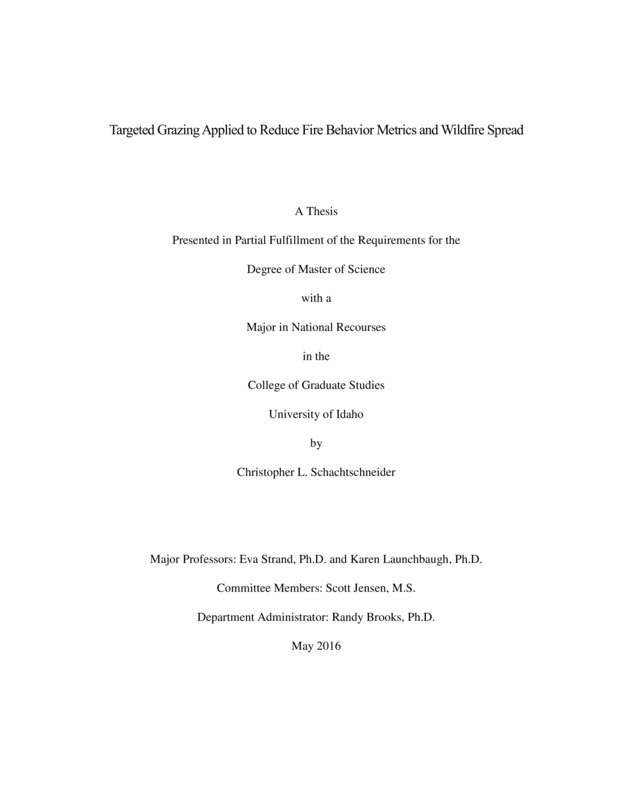Targeted Grazing Applied to Reduce Fire Behavior Metrics and Wildfire Spread
Schachtschneider, Christopher Lee. (2016). Targeted Grazing Applied to Reduce Fire Behavior Metrics and Wildfire Spread. Theses and Dissertations Collection, University of Idaho Library Digital Collections. https://www.lib.uidaho.edu/digital/etd/items/schachtschneider_idaho_0089n_10850.html
- Title:
- Targeted Grazing Applied to Reduce Fire Behavior Metrics and Wildfire Spread
- Author:
- Schachtschneider, Christopher Lee
- Date:
- 2016
- Embargo Remove Date:
- 2017-05-12
- Keywords:
- Range Management Targeted Grazing Wildfire Suppresion
- Program:
- Natural Resources
- Subject Category:
- Range management
- Abstract:
-
Increasing wildfire occurrence is a growing concern in many regions throughout the world, with wildfires increasing in size and suppression cost. Targeted grazing has been suggested as a tool to create and maintain strategic fire breaks by reducing the fine herbaceous fuel load and subsequently fire behavior metrics. We evaluated the effect of domestic cattle grazing at two seasons (summer and fall) and two utilization levels (low and moderate) on fire behavior metrics, flame height and rate of spread, in big sagebrush (Artimesia tridentata L.) communities. Cattle grazed six blocks with 30x30 m treatment plots within each block grazed at their respective season and targeted utilization. Shrub cover and herbaceous biomass before and after grazing were estimated in 2014 and 2015. Shrub canopy cover ranged from 0% to 78% within plots and dry matter herbaceous biomass ranged from 74 to 1,190 kg/ha. Prescribed burns were applied in September of 2015 where fire behavior metrics were recorded by observers and video cameras. Statistical analysis of variance revealed that grazing was an effective tool at reducing flame height and rate of spread when shrub cover was low. However, at higher shrub canopy cover, cattle grazing for fine fuel reduction may be limited due to the wildfire’s potential to carrying thought the shrub canopy.
In the second chapter, I developed a guide for managers titled ‘Guide for Quantifying Shrub Cover and Herbaceous Fuel Load in the Sagebrush Steppe’. Photos were selected for shrub cover at eight levels, 5, 10, 15, 20, 25, 30, 35, and 40% and six levels of herbaceous biomass 100, 200, 300, 400, 600, and 1000 lb/ac on a dry matter basis. Measured shrub cover, total herbaceous biomass, perennial and annual grass and forb biomass were displayed with each photo. Site descriptions are listed to increase the ability to compare amongst other ecological sites. Using this guide, fuels managers and producers will be able to quickly and economically asses the effectiveness of livestock grazing for fire fuel reduction on a site.
- Description:
- masters, M.S., Natural Resources -- University of Idaho - College of Graduate Studies, 2016
- Major Professor:
- Strand, Eva K; Launchbaugh, Karen L
- Committee:
- Jensen, Scott
- Defense Date:
- 2016
- Identifier:
- Schachtschneider_idaho_0089N_10850
- Type:
- Text
- Format Original:
- Format:
- application/pdf
- Rights:
- In Copyright - Educational Use Permitted. For more information, please contact University of Idaho Library Special Collections and Archives Department at libspec@uidaho.edu.
- Standardized Rights:
- http://rightsstatements.org/vocab/InC-EDU/1.0/

